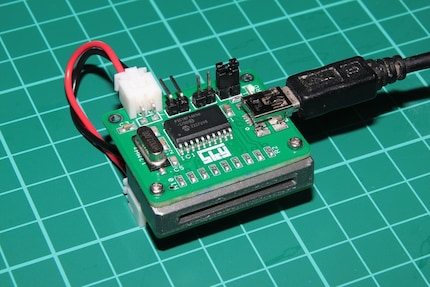
News + Trends
Design meets technology: three labels that make power spots more beautiful
by Pia Seidel

A Japanese maker, i.e. a hobbyist focussing on hardware projects, has built a punched tape reader from scratch. The device reads data at around 50 bytes per second - slow, but stable.
Japanese maker Skyriver shows on X and in his blog how he built a punched tape reader from scratch. The aim was to use as few components as possible and still create a functioning device. The paper strip is fed in manually, the data is read stably and transferred to the PC via USB.
The design is deliberately minimalist: no motors, no buffer logic, just pure manual labour when feeding the strip. This makes the reader slow, but also transparent - every step is visible and traceable. This is precisely the appeal for retro fans who not only want to use technology, but also understand it.
The centrepiece is a PIC18 microcontroller. The holes are recognised using infrared LEDs and phototransistors. The phototransistors act like small scanners: they register whether light passes through a hole or is blocked by the paper. Hole means signal «1», no hole means signal «0».

Skyriver has installed eight phototransistors for the data tracks in a classic 8-track punched tape. In addition, a ninth phototransistor monitors the so-called sprocket hole: a small, regularly spaced hole that is not intended for data, but instead mechanically moves the strip forward and serves as a clock generator. Together with 3D-printed tape guides, it ensures that each column is positioned exactly and that the data holes can be read reliably. The reader therefore has a total of nine phototransistors.
To prevent the individual light signals from getting mixed up, Skyriver had to solve a problem known in signalling technology as crosstalk: light from one track must not shine into the neighbouring track. He achieved this by using optical shields between the tracks - small physical separators that limit the light to the correct path - and by adjusting the LED current to minimise stray light.
With around 50 bytes per second, the reader reads around 50 characters per second. One byte consists of 8 bits and in many cases corresponds to one text character. This means: a long text message in around three seconds. Slow compared to today's SSDs - and also compared to classic tape readers such as the 46 kg Telefunken LSL 195, which managed up to 50,000 characters per second at the end of the 1960s. It is precisely this contrast that gives the project its charm.
It is still a prototype. Skyriver plans to put the reader in a housing - and perhaps even develop a «puncher», i.e. a punch for new punched strips.
Punched strips have a long history: as early as 1725, the French weaver Basile Bouchon used punched paper strips to control looms. His principle was further developed by Joseph-Marie Jacquard and shaped industrial textile production.

In the 19th century, punched tape found its way into music automatons and barrel organs, where it controlled the sequence of tones. From the 1930s onwards, telegraphy and teleprinters used them to reliably transmit messages.
In computer technology, punched tape became the standard medium from the 1950s: it was used as an input and storage medium for programmes and data. Many early computers used punched tape as their primary interface. Their advantages lay in their ease of manufacture, robustness and the ability to visually check data.
With the advent of magnetic tapes and floppy discs, punched tapes slowly disappeared from everyday life. What remained was their importance as a link between mechanical control and digital information - and as a symbol of the transition from the industrial to the computer era.
I find my muse in everything. When I don’t, I draw inspiration from daydreaming. After all, if you dream, you don’t sleep through life.
From the latest iPhone to the return of 80s fashion. The editorial team will help you make sense of it all.
Show all